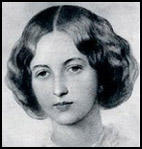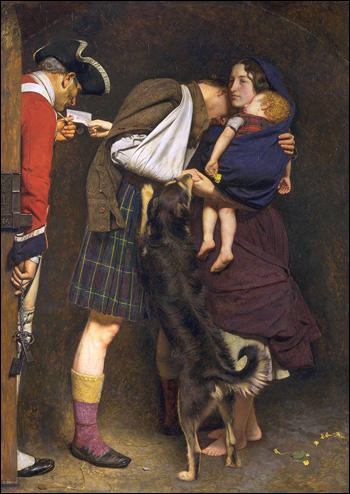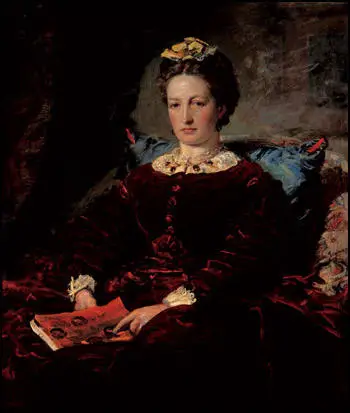Effie Ruskin Millais

Euphemia (Effie) Chalmers Gray, the daughter of a lawyer, George Gray, was born in Perth, Scotland, in 1828. Effie met John Ruskin, a family friend, when she was twelve, on a visit to Herne Hill. The following year, 1841, on a second visit, she asked him to write a fairy story. This became Ruskin's only published work of fiction, The King of the Golden River, when it was published with illustrations by Richard Doyle.
Ruskin met Effie again in October, 1847. He fell in love with the nineteen year-old and on his return to London, he wrote to George Gray asking to marry his daughter. Ruskin's parents raised no objections to the marriage, but preparations for the wedding in the following year were marred by Gray's near bankruptcy as a result of railway speculation. The wedding took place at Bowerswell House on 10th April 1848.
Marriage of Effie Ruskin
Effie later wrote to her father explaining that her marriage had not been consummated. "He alleged various reasons, hatred to children, religious motives, a desire to preserve my beauty, and, finally this last year he told me his true reason... that he had imagined women were quite different to what he saw I was, and that the reason he did not make me his wife was because he was disgusted with my person the first evening 10th April." Robert Hewison has argued: "This has been interpreted as meaning that Ruskin was equally innocent, especially in the matter of female pubic hair, but this seems unlikely, as he had seen erotic images belonging to fellow undergraduates at Oxford. There is also speculation that Effie's menstrual cycle interfered with consummation, which is plausible but not provable."
Ruskin admitted that he loved Effie passionately when he met her for the first time in 1840. After they were married he wistfully told her that "the sight of you, in your girlish beauty, which I might have had." As Suzanne Fagence Cooper, the author of The Passionate Lives of Effie Gray, Ruskin and Millais (2012) has pointed out: "John Ruskin loved young girls, innocents on the verge of womanhood. He became enchanted with twelve-year-old Effie when she visited Herne Hill in the late summer of 1840. The next time he saw her, John Ruskin felt she was 'very graceful but had lost something of her good looks'. After he had won her hand in 1847 and she was still only nineteen... Effie was too old to be truly desirable."
After returning from their honeymoon they lived at Denmark Hill and at a rented house at 31 Park Street, Mayfair. During this period John Ruskin was working on his book, The Seven Lamps of Architecture. Effie was unhappy with the state of their marriage and in February 1849, she returned to her parents in Perth and did not see her husband for nine months. In September Ruskin somewhat reluctantly travelled north to collect her. Three weeks later they set out for Venice.
Pre-Raphaelite Brotherhood
On their return to London their social and intellectual circle began to grow. This included Charles Eastlake, president of the Royal Academy and director of the National Gallery, and Frederick Denison Maurice, the leader of the Christian Socialist movement. Another friend was the poet, Coventry Patmore, who introduced him to members of the Pre-Raphaelite Brotherhood (PRB).
On the 7th May, 1851, The Times accused three members of the PRB, John Everett Millais, William Holman Hunt and Charles Allston Collins of “addicting themselves to a monkish style”, having a “morbid infatuation” and indulging in “monkish follies”. Finally, the works are dismissed as un-English, “with no real claim to figure in any decent collection of English painting.” Six days later John Ruskin had a letter published in the newspaper, where he came to the defence of the Pre-Raphaelite Brotherhood. In another letter published on 30th May, Ruskin claimed that PRB “may, as they gain experience, lay in our land the foundations of a school of art nobler than has been seen for three hundred years”.
Ruskin now published a pamphlet entitled, Pre-Raphaelitism (1851). He argued that the advice he had given in the first volume of Modern Painters had “at last been carried out, to the very letter, by a group of young men who... have been assailed with the most scurrilous abuse... from the public press.” Aoife Leahy has argued: "Ruskin’s defences had now taken a new and decidedly evangelical tone. He had formed friendships with the Pre-Raphaelite artists on the basis of his letters to The Times and, just as significantly, he had been personally harassed by members of the public for his views."
John Everett Millais
John Ruskin became a close friend of John Everett Millais and agreed that Effie should pose as the freed Jacobite prisoner's wife, in the painting, The Order of Release, 1746 (1853). Later that year Ruskin invited Millais and William Holman Hunt to go on holiday with them to Scotland. Hunt refused but Millais accepted the offer. In July they stayed in a rented cottage near Stirling. During their stay, Millais began painting portraits of Effie and Ruskin.

In November, Ruskin went on to lecture in Edinburgh whereas Millais returned to London. He had fallen in love with Effie and they continued to see each other over the next few months. On 25th April 1854 Ruskin accompanied his wife to King's Cross railway station to see her off on a visit to her parents in Scotland. That evening Ruskin was served with a legal citation at Denmark Hill, claiming the nullity of the marriage.
Effie Ruskin Millais
A medical examination confirmed Effie's virginity, but in a legal deposition that was not introduced in court, John Ruskin stated: "I can prove my virility at once." Robert Hewison has pointed out: "This was never put to the test, but it seems likely that Ruskin was referring to masturbation." He also told a male friend that he had been capable of consummating his marriage, but that he had not loved Effie sufficiently to want to do so." Following an undefended hearing in the ecclesiastical commissary court of Surrey on 15th July, the marriage was annulled on the grounds that "the said John Ruskin was incapable of consummating the same by reason of incurable impotency".
Ruskin wrote a letter to John Everett Millais stating that he wanted to remain friends. Millais replied: "I can scarcely see how you conceive it possible that I can desire to continue on terms of intimacy with you". Millais married Effie on 3rd July, 1855 and over the next few years she gave birth to eight children: Everett (1856); George (1857); Effie (1858); Mary (1860); Alice (1862); Geoffroy (1863); John (1865) and Sophie (1868).

Ian Chilvers, the author of Art and Artists (1990), has pointed out: "In the 1850s Millais's style changed, as he moved away from the brilliantly coloured, minutely detailed Pre-Raphaelite manner to a broader and more fluent way of painting." Millais defended this change by pointing out that with a family to support he could not afford to spend a whole day working on an area "no larger than a five shilling piece."
Rose La Touche
In January, 1866, John Ruskin, aged forty-six, proposed marriage to nineteen year old, Rose La Touche. She did not reject Ruskin but asked him to wait for three years. John La Touche and his wife were opposed to the marriage and Ruskin was only able to communicate with Rosa by using intermediaries, such as George MacDonald, Georgiana Cowper and Joan Agnew. In 1870 Ruskin proposed marriage again. In October, 1870, Marie wrote to Effie seeking evidence of Ruskin's impotence in order to stop the marriage. Effie confirmed this and stated that Ruskin was "utterly incapable of making a woman happy". She added that "he is quite unnatural... and his conduct to me was impure in the highest degree." She ended her letter by saying, "My nervous system was so shaken that I never will recover, but I hope your daughter will be saved."
John Everett Millais became concerned about the impact that this correspondence was having on his wife. He wrote to Rose's parents begging them to leave his wife alone. He insisted that "the facts are known to the world, solemnly sworn in God's house" and asked why this "indelicate enquiry necessary". Millais then went on to argue that Ruskin's "conduct was simply infamous, and to this day my wife suffers from the suppressed misery she endured with him." Millais feared that a consummated marriage with Rose would render the previous grounds for annulment void, and would make his marriage to Effie bigamous. Rose La Touche died aged twenty-seven and John Ruskin remained unmarried.
Later Life
In 1873 Millais bought a site on Palace Gate in Kensington and engaged the architect Philip Hardwick to build him a new house. The Millais family moved in during the early months of 1877. The impressive house reflected the artist's growing wealth and social standing. It is claimed that during a visit to the house, Thomas Carlyle is said to have remarked: "Millais, did painting do all that? Well, there must be more fools in this world than I had thought!"
John Everett Millais now concentrated on painting the portraits of the rich and famous. This included William Ewart Gladstone, Lillie Langtry, Benjamin Disraeli, Alfred Tennyson and Henry Irving. Millais's fee for a commissioned three-quarter length portrait, was normally £1,000. He told one friend: "For the last ten years I should have made £40,000 had I not given myself a holiday of four months in the year: what I did actually make was £30,000, so that I gave an estimate considerably under the fact!"
In 1893,Millais, who was a heavy smoker, was diagnosed with cancer of the larynx. On 11th May, 1896, the famous surgeon, Frederick Treves, performed an emergency tracheotomy, to enable him to breathe. Millais died at home on the afternoon of 13th August 1896, aged sixty-seven.
Effie Ruskin Millais died on 23rd December 1897.
Primary Sources
(1) Lucinda Hawksley , Katey: The Life and Loves of Dickens's Artist Daughter (2006)
By the 1870s Millais had overcome what must have seemed like overwhelming criticism of two of his works, Christ in the Carpenter's Shop (1850) and Sir Isumbras at the Ford (1857); he was now adored by the masses and the establishment and it seemed that nothing he painted could ever disappoint the art collectors. Yet despite his large and steady income, Millais' outgoings were sometimes prohibitive, with an ever-growing family, studio costs and an expensive lifestyle to be supported. Until this time, he had concentrated on crowd-pleasing genre paintings and, during the 1860s in particular, book illustrations, but as the 1870s progressed, Millais decided it was time for a change. Now in his forties, he began a new phase in his career, as a portrait painter - a profession that could prove highly lucrative.
The precocious nine-year-old genius - who had once so maddened his older, fellow Royal Academy pupils that they had dangled him out of a window by his feet until he passed out with fear - and a one-time Pre-Raphaelite rebel was now at the height of his fame. He could choose precisely whom to paint and what price to charge. His portraits, which would later include the society beauty Lily Langtry (1878) and the portrait painter Louise Jopling (1879), excited the rich and famous to clamour for his attention.
